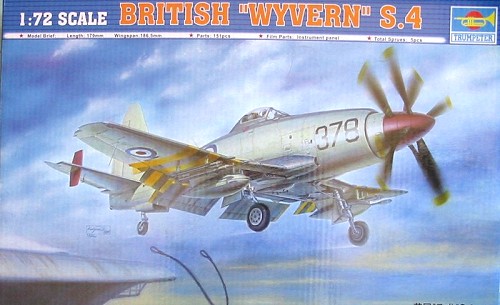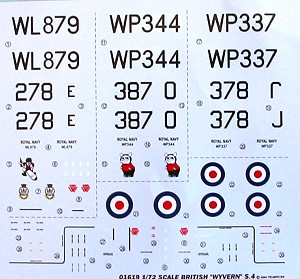
| KIT: | Trumpeter 1/72 Wyvern S.4 |
| KIT #: | 1619 |
| PRICE: | $27.95 |
| DECALS: | Three options |
| REVIEWER: | Tom Cleaver |
| NOTES: |

| HISTORY |
One major change in naval aircraft during the Second World War was the development of a single-seat strike fighter that could take on both the role of dive-bomber and torpedo-strike. In the U.S. Navy, this development led to the Douglas Skyraider, one of the most successful naval aircraft ever built; in the Royal Navy it resulted in the Westland Wyvern, surely one of the most frustrating naval aircraft ever built, an airplane that took ten years to bring to fruition, that was declared obsolete within four years of its initial arrival on British decks.
By August 1944, Westland began investigating the possibility of changing the powerplant to a turboprop. However, six Eagle-powered prototypes were ordered in November 1944. The planned turboprop was the Rolls-Royce RB.39 Clyde, which Rolls-Royce expected to deliver in December 1945.
The first Turboprop Wyvern, the N.12/45 prototype flew on January 16, 1949, powered by a R-R Clyde. While the Clyde exceeded initial performance estimates, it suffered from a variety of problems; with Rolls-Royce committed to other engine projects, the Armstrong-Siddeley Python was the only turboprop of the necessary size that could be used for the Wyvern. This decision added at least two years to the development cycle as the engineers struggled to create a throttle control that would allow the engine to be rapidly throttled back for a carrier landing, or rapidly throttled up to make a go-around, the solution being an inertia control unit that was unfortunately mechanically complex.
The Wyvern finally appeared as the S.Mk.4, which began to be delivered to RNAS Ford in May 1953 for use by 813 Squadron. These aircraft did not have the definitive engine control unit and thus were not carrier-compatible until these units were installed in the summer of 1954. The first operational Wyverns went aboard HMS Albion in September 1954. The problems were not over, as there were a series of flameouts during catapult launch as a result of fuel starvation under high-g loading while the aircraft were with Albion during a Mediterranean cruise. The Wyverns were offloaded at Hal Far, Malta, and remained there until March 1955 when they returned to England. 813 and 827 Squadrons embarked aboard HMS Eagle in May 1955 for a second Mediterranean cruise, which gave the Wyverns some 1,500 operating hours and 1,000 landings, after which the aircraft was considered proven.
The final modification of the S.Mk.4 - which appeared in early 1956 - was visually identifiable by the removal of the curved windscreen over the flat armored glass, a strengthened canopy, and dive brakes added under the wing center section, and removal of the folding wingtips resulted in an airplane that still didn’t provide the performance that was needed, and only continued on into operations due to the fact there was no alternative. The airplane was so short-ranged that it needed a large centerline fuel tank in addition to the wing tanks, which meant it could not carry a torpedo, and when it was carrying enough fuel to have an adequate range, it could not get off a carrier deck even with a catapult while carrying its maximum ordnance load.
830 Squadron went aboard HMS Eagle that May, and would be destined to be the only unit to fly the Wyvern in combat, when their nine aircraft participated in six days of strikes against Egyptian military targets in the Suez Canal Zone in October-November 1956 as part of Operation Musketeer, the Anglo-French intervention in the Sinai War. With the decommissioning of 830 and 831Squadrons in January and February 1957, 813 was the last Wyvern operational unit, embarking on HMS Eagle in July 1957 for a tour that lasted until March 1958. The survivors were all melted down during 1959, and the only Wyvern in existence today is the Wyvern Mk.1 VR137, which never actually was flown.
| THE KIT |
![]() The only other 1/72 Wyvern kits produced was one by Frog in the late
1960s/early 1970s, which for about 20 odd years was the only Wyvern kit in
existence. Czech Master Resin released an expensive kit last year. This
injection-molded kit by Trumpeter is as detailed as the Czech Master kit,
at about half the price or less.
The only other 1/72 Wyvern kits produced was one by Frog in the late
1960s/early 1970s, which for about 20 odd years was the only Wyvern kit in
existence. Czech Master Resin released an expensive kit last year. This
injection-molded kit by Trumpeter is as detailed as the Czech Master kit,
at about half the price or less.
The kit is petitely engraved, without any rivets (hurrah!). All the
moldings are sharp and crisp. All the possible ordnance loads - including
the never-used torpedo - are provided, as well as the under wing drop tanks
that were almost always carried. The flaps are separate and can be posed
up or down, as well as the dive brakes that can be posed open or closed.
The RATOG units regularly used for carrier takeoff are provided. The gear
wells are fully cast, and the cockpit is quite complete for a kit in this
scale. There is a gear in the prop assembly that looks like it would allow
the propeller to counter-rotate. The outer wing panels are provided
separately, and can be assembled folded up or down in the flying position.
The two part canopy can be posed open or closed.
wing drop tanks
that were almost always carried. The flaps are separate and can be posed
up or down, as well as the dive brakes that can be posed open or closed.
The RATOG units regularly used for carrier takeoff are provided. The gear
wells are fully cast, and the cockpit is quite complete for a kit in this
scale. There is a gear in the prop assembly that looks like it would allow
the propeller to counter-rotate. The outer wing panels are provided
separately, and can be assembled folded up or down in the flying position.
The two part canopy can be posed open or closed.
Decals are provided for three aircraft, including the de rigeur #378 from 830 Squadron in Operation Musketeer. Modelers should remember that during the actual operation, none of the Wyverns carried side numbers, since those had been overpainted with the yellow-and-black stripes, and the side number was only re-applied that December.
The only “mistake” I can find is that the wingtips are separate and the instructions would have you pose them folded down if you fold the wings. The kit represents the final version of the Wyvern S.Mk.4, and by that time the folding wingtips had been done away with.
| CONCLUSIONS |
Definitely one of Trumpeter’s best to date, and the best Wyvern kit yet in any scale for price and detail. I am not usually a 1/72 modeler, but I am making an exception in this case. Trumpeter has announced a 1/48 version to be released later this year. If they only pantograph this up (without the @#$##@@ engraved rivets), it will be perfect. And then, perhaps, next year they will release it in 1/32??? One can dream.
Buy it in confidence.
May 2005
Review Kit courtesy of Stevens International.
If you would like your product reviewed fairly and quickly by a site that has nearly 300,000 visitors a month, please contact me or see other details in the Note to Contributors.